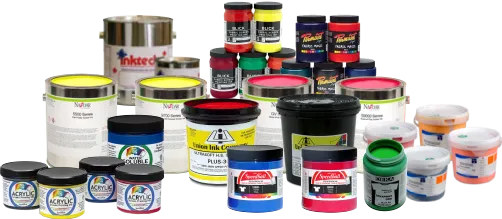This article addresses the topic of silkscreen inks – inks used in screen printing and their relationship with the surface to be printed, taking into account other variables such as ambient temperature and air humidity. This is an important theme for any printing or painting technique, the correct choice of ink largely interferes with a good result, both in the final product and in its durability.
Silkscreen Ink And Substrate
Substrate is the technical term that refers to the surface that is intended to be printed on, be it paper, plastic, fabric, glass, wood, tile, etc.
To ensure good ink adhesion and avoid clogging the screen holes, the substrates must be very clean and dry when printing. The chemical characteristics (composition) and physical (shape and roughness) of the substrate, as well as the ambient temperature and humidity, define the type of ink to be used and any necessary prior procedures.
For example, in the case of printing on glass, if the air humidity is high, the glass may have to be heated before printing; or for polypropylene or polyethylene substrates, it is natural to have to mix a specific additive into the ink or to opt for a pretreatment based on high-frequency discharges that optimize the surface properties so that it becomes more adherent.
Regarding inks, they can be divided into three main groups, according to the drying mode:
1. Evaporation and oxidation (water-based and solvent-based, or mixed inks)
2. Thermosetting (plastisol inks)
3. UV hardening (Ultra Violet curing inks)
⓵ The first group of silkscreen ink refers to paints that dry in air, either through evaporation or oxidation (reaction to oxygen). Exclusively water-based paints are considered the most environmentally friendly – they do not emit volatile organic compounds into the atmosphere – so there has been special interest in their development, but unfortunately the range of substrates covered by these paints is still limited, making solvent-based inks, such as multipurpose, acrylic, vinyl and enamel inks, the best choice for most substrates (metal, certain plastics, wood, glass, cardboard, aluminum, vinyl, etc.), despite their pollutants.
Water-based inks dry more slowly (about 1 hour) and are used mainly on paper and cardboard, extendable to some textiles and some plastics. Acrylic and vinyl inks dry faster (15 to 30 minutes) than enamel inks (4 to 6 hours), but remain vulnerable to solvents after drying, unlike enamel paints. Either of these inks has the disadvantage of drying out during printing in hot and dry environments, necessitating the use of a retarder to avoid the situation.
⓶ The second group of silkscreen ink includes plastisol inks (based on PVC and liquid plasticizer additive), those that do not air dry, remaining moist as long as they are not subjected to heat – almost exclusively used in textile printing. For this type of ink, the term drying does not apply, but rather the term curing or polymerization (union of identical molecules) of the resin contained.
Epoxy inks (compound formed from an epoxide – oxygen and carbon) can be considered in this group. This type of ink cures via chemical reaction between the base and a separately added catalyst, but the use of heat is also common on various substrates as a way to make the print more resistant and durable – commonly used in printing glass, metal, ceramics and some plastics. Plastisol inks can cure in 2 to 4 minutes, while epoxy inks can take 4 to 7 days to fully cure.
⓷ The third group of silkscreen ink involves curing paint by exposure to a light source that is strongly rich in ultra violet rays. This is a highly environmentally friendly ink – 0% volatile content and 100% pigment – it cures very quickly and has the advantage of not hardening during printing, similar to plastisol ink. Applicable to all substrates, it is considered by many professionals to be the great trend of the future. However, the cost of its application is still quite high, since it requires expensive equipment that is only viable in the industrial environment.
The heat method can also be applied to solvent-based paints with the aim of accelerating drying time. Heat application is usually done through an industrial oven or heat press for some textiles, but an iron, hair dryer, or kitchen oven can be used for home screen printing, depending on the substrate.
For simple practical examples for beginners the Speedball type aqueous ink is usually taken as a reference on silkscreen ink; ecological, water-based, easy to dilute and clean, with no additives needed in mild environments, or special procedures; ideal for paper, cardboard and cardstock. Multipurpose inks or aqueous acrylic textile inks are also a good starting option, more versatile on substrates and easy to dilute and clean.
The following set of tables presents a summary of characteristics of some of the most popular types of paints and brands on the market, among water-based, solvent-based and plastisol options, by way of comparison and illustration of the concepts presented so far. Besides the paints presented, there are countless variants, among colors and special finishes, such as glitter, fluorescent, textured, and metallic, among others.

Silkscreen Ink and Substrates
NAZDAR ENAMEL PAINT 59000
Substrates : metal, wood, glass, aluminum, masonite, cardboard and some hard plastics
Type of stencil : direct emulsion and solvent resistant capillary film
Type of screen : monofilament 78T to 110T
Type of squeegee : polyurethane 70A to 80A
Dilution : varnish 59000 Nazdar
Drying : 4 to 8 hours in open air or 30 minutes at 83ºC
Cleaning : solvent or thinner
Application : interior and exterior
Finishing : glossy
NAZDAR PAPER SPECIAL INK 5500
Substrates : paper, coated papers, cardboard and board
Type of stencil : direct emulsion and solvent resistant capillary film
Type of screen : polyester monofilament 70T to 110T
Type of squeegee : polyurethane 70A to 80A
Dilution : diluent 5500 or retarder 9050 Nazdar
Drying : 20 to 30 minutes in air, or just seconds at 44ºC to 55ºC
Cleaning : solvent or diluent
Application : interior and exterior (short term)
Finishing : matte
NAZDAR 9700 MULTI-PURPOSE PAINT
Substrates styrene, coated papers and cardboard, malleable vinyl and rigid vinyl, acrylic, polyethylene fibers and some synthetic plastics
Type of stencil direct emulsion and solvent resistant capillary film
Type of screen monofilament 90T to 140T
Type of squeegee polyurethane 70A to 80A
Dilution diluent Re180 Nazdar
Drying 15 to 20 minutes in air or 40 to 60 seconds at a temperature between 32ºC and 63ºC
Cleaning solvent or diluent
Application : interior and exterior
Finishing : glossy
VINYL GLOSS PAINT NAZDAR GV SERIES
Substrates vinyl, polycarbonate, acrylic and some synthetic plastics
Type of stencil direct emulsion and solvent resistant capillary film
Type of screen polyester monofilament 60T to 120T
Type of squeegee polyurethane 70A to 80A
Dilution diluent 5500 or retarder 9050 Nazdar
Drying drying 20 to 40 minutes in air (requires good ventilation)
Cleaning solvent or diluent
Application interior and exterior
Finishing : glossy
AQUEOUS ACRYLIC TEXTILE PAINT FRAMACRYL 800
Substrates synthetic fabrics, paper and its derivatives
Type of stencil direct emulsion or water-resistant capillary film
Type of screen monofilament 86T to 124T
Type of squeegee polyurethane, neoprene or nitrile 65A to 75A
Dilution water
Drying 1 hour in air or 4 minutes at 130ºC to 140ºC
Cleaning water
Application interior and exterior
Finishing matte
Washing : hand wash or machine wash and dry
GLOSS LACQUER PAINT INKTECH GLL
Substrates Lacquered substrates and coated media, pyroxylin, wood, treated polyester, paper, cardboard, cardstock
Type of stencil direct or indirect emulsion or solvent resistant capillary film
Type of screen monofilament polyester 200T to 300T
Type of squeegee polyurethane 70A to 80A
Dilution diluent GLL 1800 Inktech
Drying 20 to 40 minutes in air or 20 to 45 seconds at 66ºC to 93º C
Cleaning solvent or diluent
Application : interior and exterior
Finishing : glossy
SPEEDBALL WATER-BASED INK
Substrates paper, cardboard, cardboard
Type of stencil direct emulsion or water-resistant capillary film
Type of screen monofilament 86T to 160T multifilament 8XX to 12XX
Type of squeegee polyurethane, neoprene or nitrile 65A to 75A
Dilution water
Drying Air drying 1 hour
Cleaning soap and water
Application interior
Finishing matte
PLASTISOL ULTRASOFT INK
Substrates natural cotton, synthetic cotton
Type of stencil direct emulsion and solvent resistant capillary film
Type of screen monofilament 86T to 305T
Type of squeegee polyurethane 70A to 90A
Dilution reducer (do not use solvent)
Drying 2 to 4 minutes at 154ºC
Cleaning solvent or diluent
Application interior and exterior
Finishing glossy or satin
Washing hand or machine washable, not dry cleanable, requires caution when ironing
SPEEDBALL PERMANENT ACRYLIC PAINT
Substrates paper, cardboard and wood
Type of stencil direct emulsion and water-resistant capillary film
Type of screen monofilament 86T to 160T multifilament 8XX to 12XX
Type of squeegee polyurethane, neoprene or nitrile 65A to 75A
Dilution water
Drying 20 minutes in air or 3 to 5 minutes at 135º C
Cleaning soap and water
Application interior and exterior
Finishing semi-glossy
MAXOPAKE PLASTISOL INK
Substrates dark textiles, natural cotton and synthetic cotton
Type of stencil direct emulsion and solvent resistant capillary film
Type of screen polyester monofilament 74T to 125T
Type of squeegee polyurethane 70A to 90A
Dilution reducer (do not use solvent)
Drying 2 to 4 minutes at 149ºC
Cleaning solvent or diluent
Application interior and exterior
Finishing glossy or satin
Washing hand or machine washable, not dry cleanable, requires caution when ironing
AQUEOUS ACRYLIC TEXTILE DICK BLICK
Substrates synthetic fabrics, paper and its derivatives
Type of stencil direct emulsion or water-resistant capillary film
Type of screen monofilament 86T to 124T multifilament 8XX to 10XX
Type of squeegee polyurethane, neoprene or nitrile 65A to 75A
Dilution water
Drying 3 minutes at 149ºC
Cleaning immediately after printing with soap and warm water
Application interior and exterior
Finishing matte
Washing hand wash, machine wash and dry
DEKA PRINT TEXTILE DYE
Substrates natural cotton, synthetic cotton
Type of stencil direct emulsion or water-resistant capillary film
Type of screen monofilament 100T to 200T multifilament 10XX to 16XX
Type of squeegee polyurethane, neoprene or nitrile 65A to 75A
Dilution water
Drying 5 minutes at 150ºC
Cleaning water
Application interior and exterior
Finishing matte
Washing hand wash or machine wash and dry
PERMASET TEXTILE DYE
Substrates most fabrics except nylon
Type of stencil direct emulsion or water-resistant capillary film
Type of screen monofilament 43T to 120T
Type of squeegee polyurethane, neoprene or nitrile 65A to 75A
Dilution water
Drying 2 to 3 minutes at 160ºC, 5 to 6 minutes at 140ºC and 8 to 9 minutes at 120ºC
Cleaning water
Application interior and exterior
Finishing matte
Washing hand wash, machine wash and dry
SPEEDBALL WATER-BASED TEXTILE DYE
Substrates natural and synthetic cotton
Type of stencil direct emulsion and water-resistant capillary film
Type of screen monofilament 74T to 124T and multifilament 6XX to 10XX
Type of squeegee polyurethane, neoprene or nitrile 65A to 75A
Dilution water
Drying 3 to 5 minutes at 190ºC with pressure (heat press or iron)
Cleaning water
Application interior and exterior
Finishing matte
Washing hand wash or machine wash and dry
Find references and more knowledge in Learning Links

